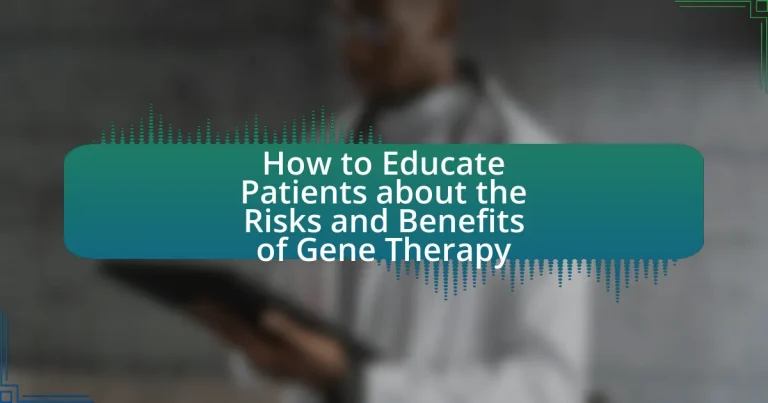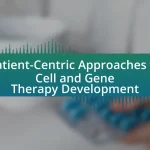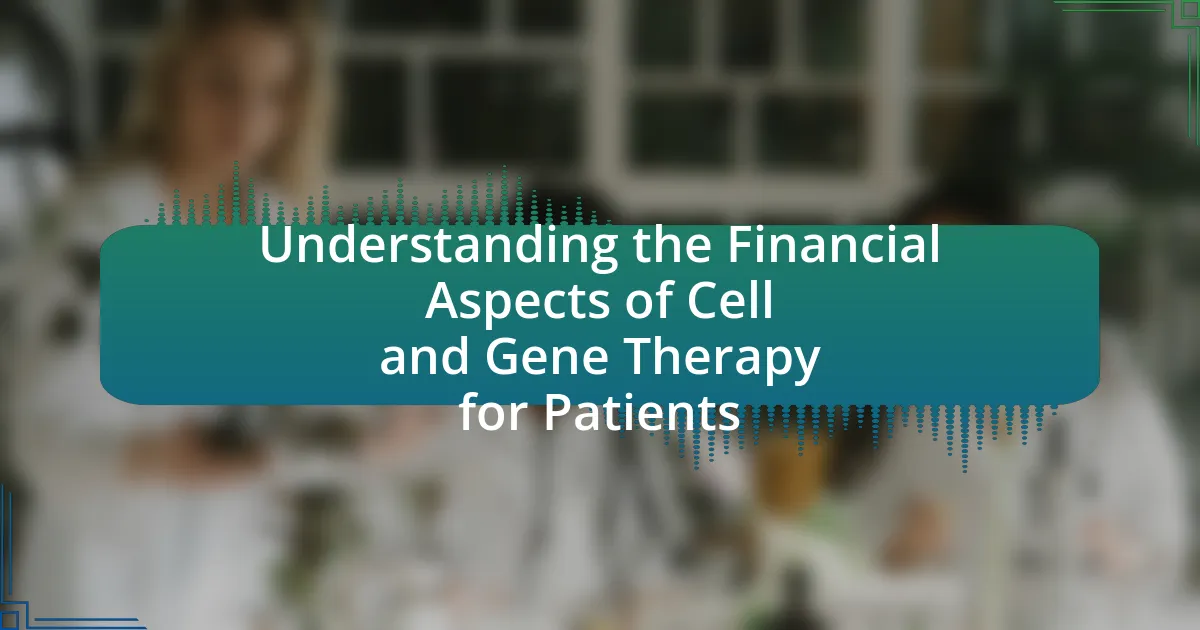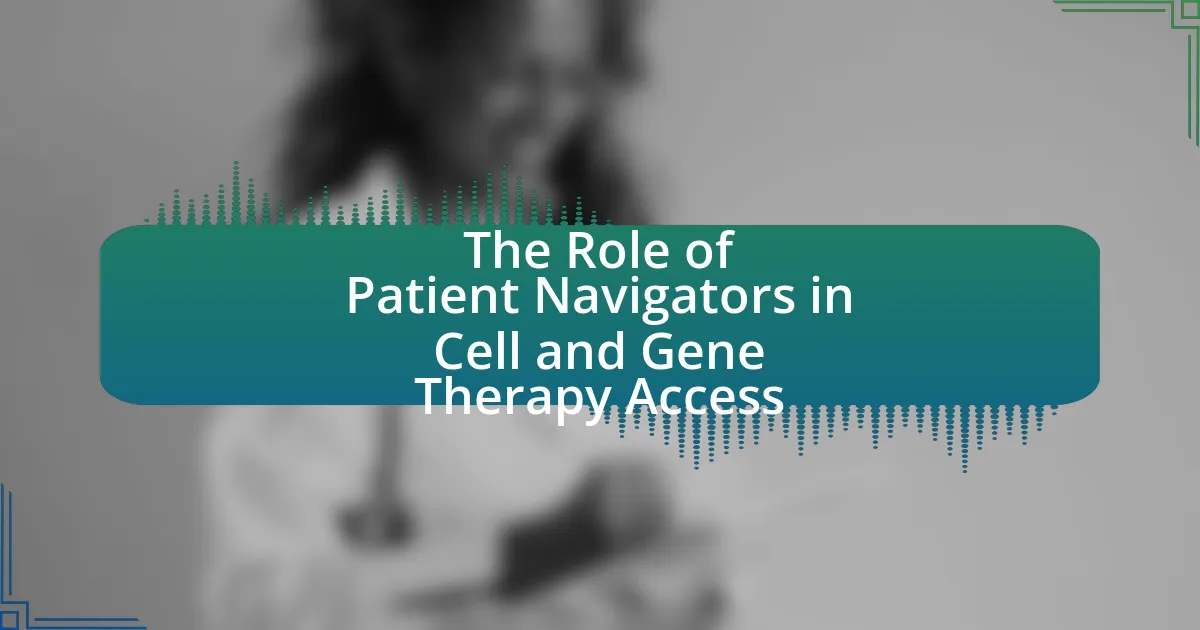Gene therapy is a medical technique that modifies genes within a patient’s cells to treat or prevent diseases, particularly genetic disorders. Patient education is essential in this context, as it helps individuals understand the risks and benefits of the treatment, including potential side effects and the necessity for ongoing monitoring. The article outlines how gene therapy works, its various types, mechanisms of action, and the associated risks, both short-term and long-term. It emphasizes the importance of effective communication strategies for healthcare providers to educate patients, ensuring they make informed decisions regarding their treatment options. Additionally, the article highlights available resources for patients and providers to enhance understanding and support in the evolving field of gene therapy.
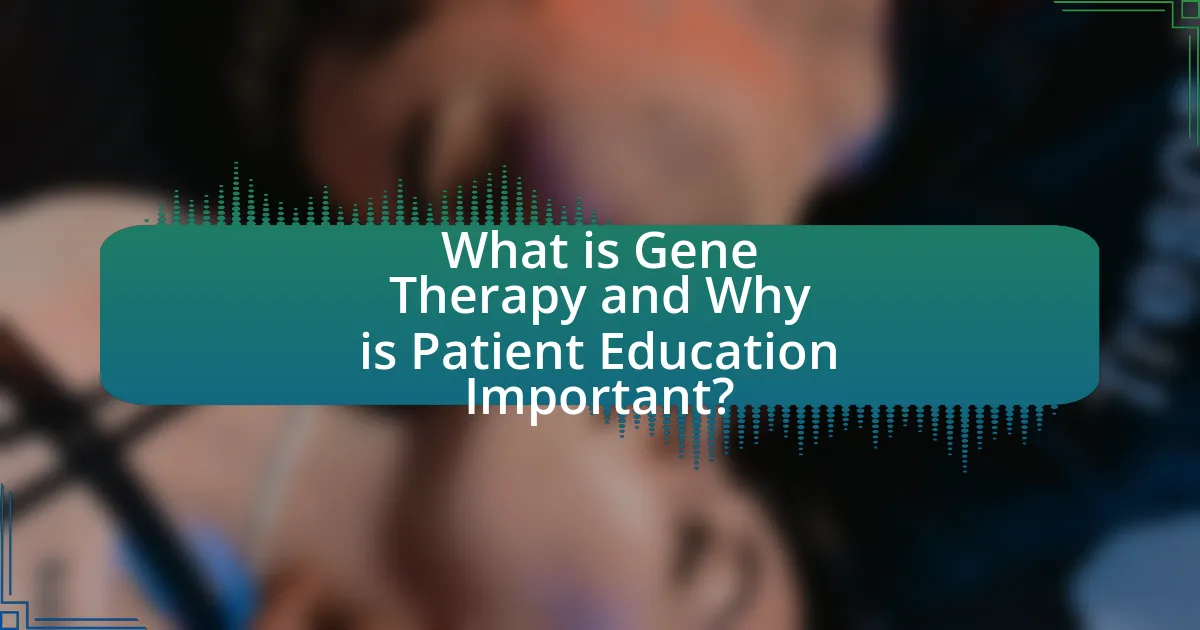
What is Gene Therapy and Why is Patient Education Important?
Gene therapy is a medical technique that involves altering the genes inside a patient’s cells to treat or prevent disease. This approach can address genetic disorders by correcting defective genes or introducing new genes to help fight diseases. Patient education is crucial in gene therapy because it ensures that patients understand the potential risks and benefits associated with the treatment, which can include side effects, the possibility of incomplete treatment, and the need for ongoing monitoring. Educated patients are more likely to make informed decisions about their treatment options, adhere to protocols, and engage in discussions with healthcare providers, ultimately leading to better health outcomes.
How does Gene Therapy work?
Gene therapy works by introducing, removing, or altering genetic material within a patient’s cells to treat or prevent disease. This process typically involves the use of vectors, often modified viruses, to deliver therapeutic genes into the target cells. For instance, in conditions like cystic fibrosis or certain types of inherited blindness, gene therapy aims to replace defective genes with functional ones, thereby restoring normal function. Clinical trials have demonstrated the efficacy of gene therapy; for example, the FDA approved Luxturna in 2017, which treats a rare form of inherited vision loss by delivering a correct copy of the RPE65 gene directly to retinal cells.
What are the different types of Gene Therapy?
The different types of gene therapy include somatic gene therapy, germline gene therapy, and gene editing. Somatic gene therapy targets non-reproductive cells to treat diseases by introducing therapeutic genes, while germline gene therapy involves modifications to reproductive cells, potentially affecting future generations. Gene editing, such as CRISPR-Cas9, allows for precise alterations in the DNA sequence to correct genetic defects. These classifications are essential for understanding the applications and implications of gene therapy in medical treatments.
What are the mechanisms of action in Gene Therapy?
Gene therapy primarily operates through three mechanisms of action: gene addition, gene editing, and gene silencing. Gene addition involves introducing a functional copy of a gene to compensate for a defective one, thereby restoring normal function. Gene editing utilizes technologies like CRISPR-Cas9 to directly modify the DNA sequence, correcting mutations at specific locations. Gene silencing employs techniques such as RNA interference to inhibit the expression of harmful genes. These mechanisms have been validated through numerous studies, demonstrating their effectiveness in treating genetic disorders and certain diseases, such as spinal muscular atrophy and hemophilia.
What are the potential risks associated with Gene Therapy?
The potential risks associated with gene therapy include immune reactions, insertional mutagenesis, and off-target effects. Immune reactions can occur when the body recognizes the introduced genetic material as foreign, leading to inflammation or other adverse responses. Insertional mutagenesis happens when the therapeutic gene integrates into the host genome in a way that disrupts normal gene function, potentially leading to cancer. Off-target effects refer to unintended modifications of other genes, which can result in harmful consequences. These risks highlight the need for thorough preclinical and clinical evaluations to ensure patient safety.
What are the short-term risks of Gene Therapy?
The short-term risks of gene therapy include immune reactions, insertional mutagenesis, and off-target effects. Immune reactions can occur when the body recognizes the introduced genetic material as foreign, potentially leading to inflammation or other adverse responses. Insertional mutagenesis refers to the unintended integration of the therapeutic gene into the host genome, which can disrupt normal gene function and lead to malignancies. Off-target effects involve unintended modifications to other genes, which may result in harmful consequences. These risks highlight the importance of thorough preclinical and clinical evaluations to ensure patient safety.
What are the long-term risks of Gene Therapy?
The long-term risks of gene therapy include potential insertional mutagenesis, immune responses, and off-target effects. Insertional mutagenesis can occur when the therapeutic gene integrates into unintended locations in the genome, potentially leading to oncogenesis, as evidenced by cases in clinical trials where patients developed leukemia due to gene therapy. Immune responses may arise against the introduced vectors or the therapeutic proteins, which can diminish the efficacy of the treatment and cause adverse reactions. Off-target effects refer to unintended modifications in the genome that can disrupt normal gene function, posing risks of harmful side effects. These risks highlight the need for careful monitoring and long-term follow-up in gene therapy patients.
What benefits does Gene Therapy offer to patients?
Gene therapy offers patients the potential for long-term treatment or even cures for genetic disorders by directly targeting the underlying genetic causes of diseases. This innovative approach can lead to significant improvements in quality of life, as it aims to correct or replace faulty genes responsible for various conditions. For instance, clinical trials have demonstrated that gene therapy can effectively treat inherited retinal diseases, resulting in restored vision for some patients. Additionally, gene therapy has shown promise in treating certain types of cancer by enhancing the body’s immune response against tumors. These benefits highlight the transformative potential of gene therapy in modern medicine, providing hope for patients with previously untreatable conditions.
How can Gene Therapy improve patient outcomes?
Gene therapy can improve patient outcomes by directly targeting and correcting genetic defects that cause diseases. This innovative approach allows for the potential treatment or even cure of conditions such as cystic fibrosis, hemophilia, and certain types of cancer by delivering functional genes to replace or repair faulty ones. For instance, the FDA-approved gene therapy Zolgensma has shown significant efficacy in treating spinal muscular atrophy, leading to improved motor function and survival rates in affected infants. Such targeted interventions can reduce the need for lifelong treatments and hospitalizations, ultimately enhancing the quality of life for patients.
What conditions can be treated with Gene Therapy?
Gene therapy can treat a variety of genetic disorders, including inherited conditions such as cystic fibrosis, hemophilia, and muscular dystrophy. Additionally, it has shown promise in treating certain types of cancer, such as leukemia and lymphoma, as well as some viral infections like HIV. Clinical trials and research have demonstrated the efficacy of gene therapy in correcting defective genes responsible for disease development, thereby improving patient outcomes. For instance, the FDA approved the gene therapy Zolgensma for spinal muscular atrophy, showcasing its potential in addressing severe genetic conditions.
How can healthcare providers effectively educate patients about Gene Therapy?
Healthcare providers can effectively educate patients about gene therapy by utilizing clear communication, tailored educational materials, and interactive discussions. Clear communication involves explaining complex concepts in simple terms, ensuring patients understand the mechanisms, potential benefits, and risks associated with gene therapy. Tailored educational materials, such as brochures or videos, can address specific patient needs and concerns, enhancing comprehension. Interactive discussions, including Q&A sessions, allow patients to voice their questions and receive personalized responses, fostering a supportive environment for learning. Research indicates that patients who engage in interactive education are more likely to retain information and make informed decisions regarding their treatment options.
What strategies can be used to communicate risks and benefits?
Effective strategies to communicate risks and benefits include using clear, simple language, visual aids, and personalized discussions. Clear language ensures that patients understand complex medical terms, while visual aids like charts or infographics can illustrate potential outcomes and probabilities, making the information more accessible. Personalized discussions allow healthcare providers to address individual patient concerns and tailor information to their specific context, enhancing comprehension and retention. Research indicates that patients who receive information in a clear and personalized manner are more likely to make informed decisions regarding their treatment options, as evidenced by studies showing improved patient understanding and satisfaction in healthcare settings.
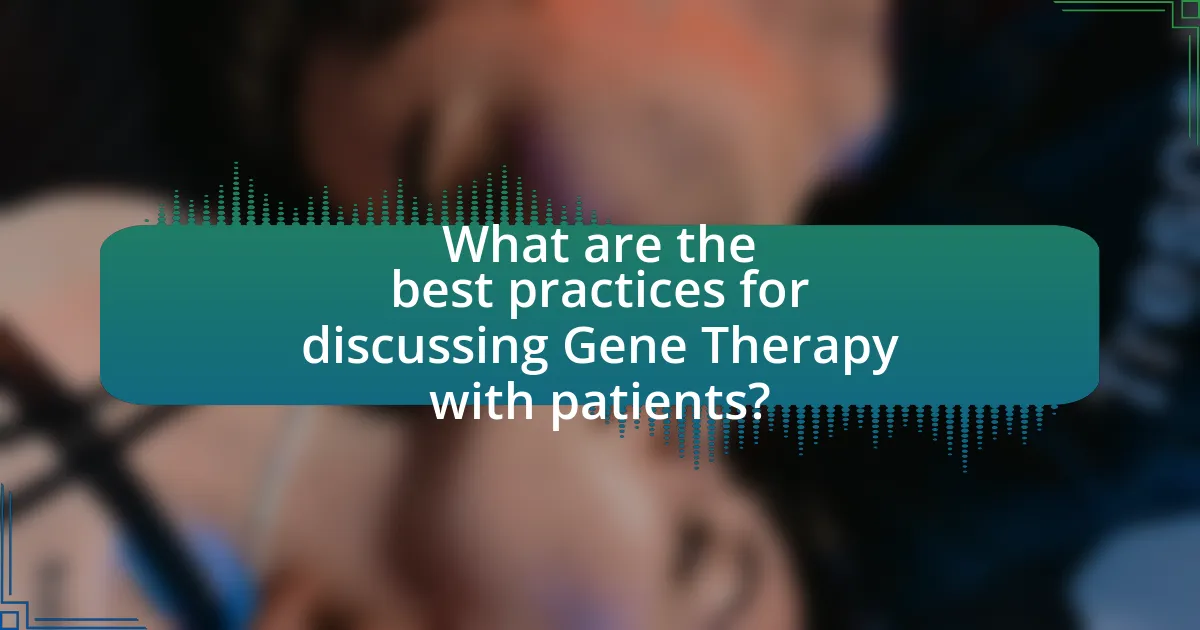
What are the best practices for discussing Gene Therapy with patients?
The best practices for discussing gene therapy with patients include clear communication, addressing patient concerns, and providing comprehensive information about risks and benefits. Clear communication ensures that patients understand complex concepts, while addressing concerns fosters trust and encourages questions. Providing comprehensive information involves discussing potential outcomes, side effects, and the current state of research, which is crucial as studies show that informed patients are more likely to engage in their treatment decisions. For instance, a study published in the journal “Nature Reviews Genetics” highlights that effective patient education significantly improves adherence to treatment protocols and overall satisfaction with care.
How can providers tailor information to individual patient needs?
Providers can tailor information to individual patient needs by assessing each patient’s unique medical history, preferences, and comprehension levels. This personalized approach allows healthcare professionals to deliver relevant information that resonates with the patient’s specific circumstances. For instance, studies show that using plain language and visual aids can enhance understanding, particularly for patients with varying literacy levels. Additionally, engaging patients in shared decision-making fosters a sense of ownership and ensures that the information provided aligns with their values and concerns. This method not only improves patient satisfaction but also promotes adherence to treatment plans, as evidenced by research indicating that tailored communication significantly increases patient engagement and outcomes in healthcare settings.
What factors should be considered when assessing patient understanding?
When assessing patient understanding, factors such as health literacy, cognitive ability, emotional state, and prior knowledge of the subject matter must be considered. Health literacy influences how well patients can comprehend medical information, with studies indicating that approximately 36% of adults in the U.S. have limited health literacy, which can hinder their understanding of complex topics like gene therapy. Cognitive ability affects the processing of information, while emotional state can impact a patient’s focus and retention of information. Additionally, prior knowledge about gene therapy can shape how new information is interpreted, making it essential to gauge what patients already know. These factors collectively inform the effectiveness of educational strategies tailored to enhance patient comprehension of the risks and benefits associated with gene therapy.
How can visual aids enhance patient comprehension?
Visual aids enhance patient comprehension by simplifying complex information and making it more accessible. For instance, diagrams and charts can illustrate the mechanisms of gene therapy, allowing patients to visualize processes that are otherwise abstract. Research indicates that patients who receive information through visual aids retain 65% more information compared to those who rely solely on verbal explanations. This increased retention is crucial in healthcare settings, where understanding risks and benefits can significantly impact patient decision-making.
What role does informed consent play in Gene Therapy education?
Informed consent is crucial in gene therapy education as it ensures that patients fully understand the risks, benefits, and implications of the treatment. This process empowers patients to make knowledgeable decisions regarding their healthcare, fostering trust and transparency between healthcare providers and patients. Research indicates that effective informed consent processes can significantly enhance patient comprehension and satisfaction, as evidenced by a study published in the journal “Genetics in Medicine,” which found that patients who received thorough explanations of gene therapy procedures were more likely to engage in their treatment decisions. Thus, informed consent not only protects patient autonomy but also enhances the overall educational experience in gene therapy contexts.
What should be included in the informed consent process?
The informed consent process should include a clear explanation of the purpose of the gene therapy, the potential risks and benefits, alternative treatment options, and the right to withdraw consent at any time. This ensures that patients are fully aware of what the treatment entails and can make an informed decision. According to the National Institutes of Health, informed consent is a fundamental ethical requirement in clinical research, emphasizing the necessity for transparency and understanding in patient participation.
How can providers ensure patients feel comfortable asking questions?
Providers can ensure patients feel comfortable asking questions by fostering an open and supportive communication environment. This can be achieved through active listening, encouraging dialogue, and validating patient concerns. Research indicates that when healthcare providers demonstrate empathy and approachability, patients are more likely to engage in discussions about their health, including complex topics like gene therapy. For instance, a study published in the Journal of Patient Experience found that patients who perceived their providers as approachable were 30% more likely to ask questions during consultations.
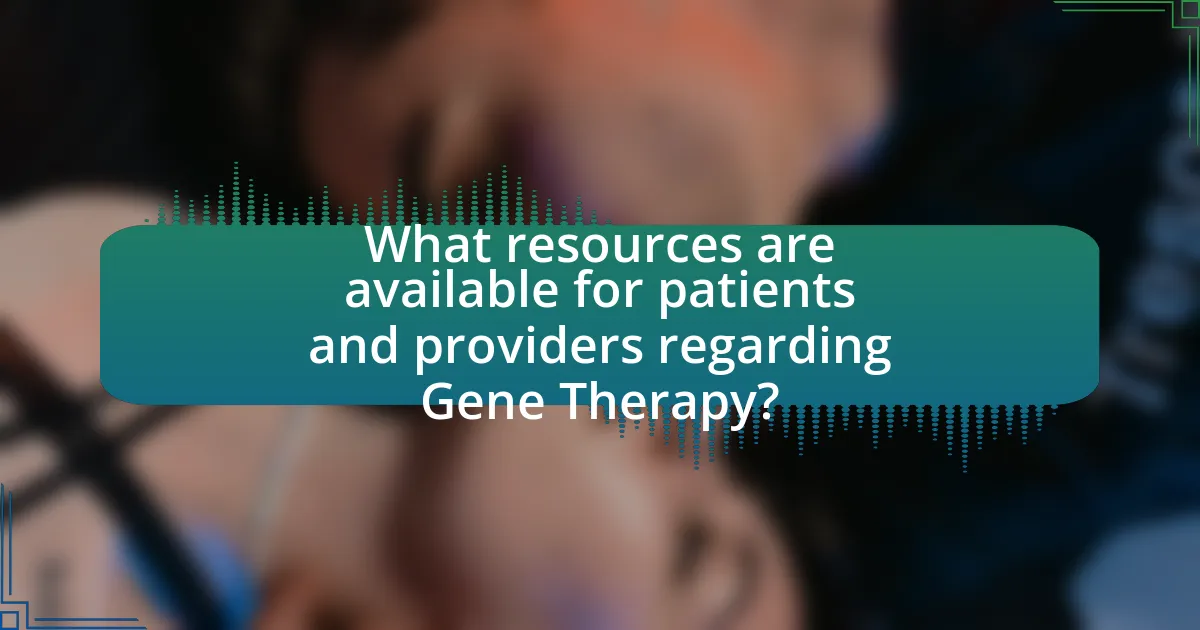
What resources are available for patients and providers regarding Gene Therapy?
Resources available for patients and providers regarding gene therapy include educational websites, clinical trial registries, and professional organizations. The National Institutes of Health (NIH) provides comprehensive information through its Genetic and Rare Diseases Information Center, which offers resources on gene therapy options and ongoing research. Additionally, the American Society of Gene & Cell Therapy (ASGCT) offers educational materials specifically designed for both patients and healthcare providers, including webinars and fact sheets that explain the risks and benefits of gene therapy. ClinicalTrials.gov is another valuable resource, listing ongoing clinical trials related to gene therapy, which can help patients and providers stay informed about the latest advancements and treatment options.
How can patients access reliable information about Gene Therapy?
Patients can access reliable information about gene therapy through reputable medical organizations, academic institutions, and government health agencies. Resources such as the National Institutes of Health (NIH) and the American Society of Gene & Cell Therapy provide comprehensive, evidence-based information on gene therapy, including its risks and benefits. Additionally, peer-reviewed journals and clinical trial registries, like ClinicalTrials.gov, offer insights into ongoing research and findings related to gene therapy. These sources ensure that patients receive accurate and up-to-date information, helping them make informed decisions regarding their treatment options.
What organizations provide support and resources for Gene Therapy patients?
Organizations that provide support and resources for gene therapy patients include the National Organization for Rare Disorders (NORD), the Genetic and Rare Diseases Information Center (GARD), and the American Society of Gene & Cell Therapy (ASGCT). NORD offers information and advocacy for patients with rare diseases, including those undergoing gene therapy. GARD provides comprehensive resources and support for individuals affected by genetic and rare diseases, facilitating access to information about gene therapy options. ASGCT focuses on advancing the field of gene and cell therapy through education, research, and advocacy, offering resources specifically tailored to patients and healthcare providers.
How can healthcare providers stay updated on Gene Therapy advancements?
Healthcare providers can stay updated on gene therapy advancements by regularly engaging with scientific literature, attending professional conferences, and participating in specialized training programs. Accessing peer-reviewed journals such as “Nature Reviews Genetics” and “Molecular Therapy” provides the latest research findings and clinical trial results. Additionally, attending conferences like the American Society of Gene & Cell Therapy Annual Meeting allows providers to network with experts and learn about cutting-edge developments. Continuous education through accredited courses ensures that healthcare professionals remain informed about evolving gene therapy techniques and their implications for patient care.
What are the key takeaways for effective patient education on Gene Therapy?
Key takeaways for effective patient education on gene therapy include clear communication of the therapy’s purpose, potential benefits, and associated risks. Educators should use simple language to explain complex concepts, ensuring patients understand how gene therapy works and its implications for their health. Providing visual aids and written materials can enhance comprehension. Additionally, addressing patients’ questions and concerns fosters trust and engagement. Evidence shows that informed patients are more likely to adhere to treatment plans and report satisfaction with their care, highlighting the importance of thorough education in the context of gene therapy.
